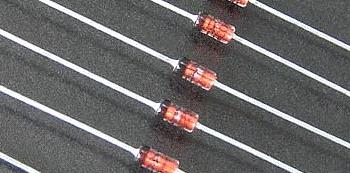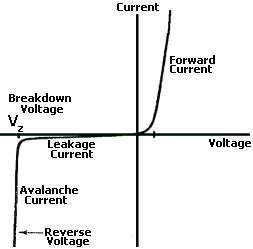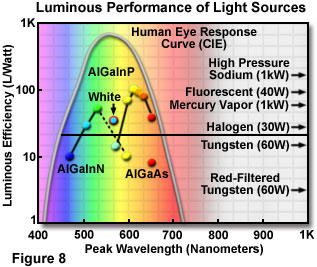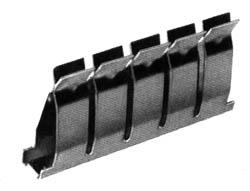Dual-tone multi-frequency (DTMF) signaling is used for telephone signaling over the line in the voice-frequency band between telephone handsets and the call switching center. The version of DTMF used for telephone tone dialing is known by the trademarked term Touch-Tone, and is standardized by ITU-T Recommendation Q.23.
There are twelve DTMF signals, each of which is made up of two tones from the following selection: 697 Hz, 770 Hz, 852 Hz, 941 Hz, 1209 Hz, 1336 Hz, 1477Hz,1633Hz, chosen such that it is easy to design filters and to transmit the tones through a telephone line having bandwidth of approximately 3.5 kHz
These tones are divided into two groups (low and high), and each DTMF signal uses one from each group. This prevents any harmonics from being misinterpreted as part of the signal.
The following table shows the frequencies used for each signal:

The signal is encoded as a pair of sinusoidal (sine wave) tones from the table below which are mixed with each other. DTMF is used by most PSTN (public switched telephone networks) systems for number dialling, and is also used for voice-response systems such as telephone banking and sometimes over private radio networks to provide signalling and transferring of small amounts of data.
For example, in order to generate the DTMF tone for "1", we should mix a pure 697Hz signal with a pure 1209 Hz signal

The higher of the two frequencies is normally aloud by 4dB, and this shift is termed as twist. DTMF standard specifies 50ms tones and 600ms duration between two successive tones.
#,*,A,B,C,D Keys:
� These are widely used for vertical service codes such as *67 in the United States and Canada to suppress caller ID.
� Public payphones that accept credit cards use these additional codes to send the information from the magnetic strip.
� The U.S. military also used the letters, relabeled, in their Autovon phone system. Here they were used before dialing the phone in order to give some calls priority, cutting in over existing calls if need be.
� Inbound phone calls are processed using our IVR software and automatic call distribution (ACD) system that answers calls without an operator.
ABCD Tones:
The ABCD tones are simply additional DTMF tones that may be used in any way the standard (0-9) tones are used.
� A � Flash
� B � Flash override priority
� C � Priority communication
� D � Priority override
The A, B, C and D tones are used in amateur radio phone patch and repeater operations to allow, among other uses, control of the repeater while connected to an active phone line.
Some cable television networks and radio networks to signal the local cable company/network station to insert a local advertisement or station identification also use DTMF tones.

At one time it was possible to use the ABCD tones to access a special maintenance mode of the Automatic Call Distributor (ACD) systems used by Directory Assistance operators to connect two callers together.
GENERATING DTMF:
ICs or by using RC networks connected to a microprocessor. MT8880 is an example of a dedicated IC. But getting the latter method work is a bit difficult if high accuracy is needed. The crystal frequency needs to be sacrificed for a non standard cycle length.. Hence this method is used for simple applications DTMF signals can be generated through dedicated. Most often, a PIC micro could be used for the above purpose.

DECODING DTMF:

Detecting DTMF with satisfactory precision is a hard thing. Often, a dedicated IC such as MT8870 is used for this purpose. It uses two 6th order band-pass filters using switched capacitor filters and it suppresses any harmonics. Hence they can produce pretty good sine waves from distorted input. Hence it is preferred. Again microprocessors can also be used, but their application is limited.
The Telephony Application Program Interface (TAPI) provides a way for a program to detect DTMF digits.
Detection of calling Numbers:
An international number consists of a Country Code (CC) and a National (Significant) Number (N(S)N). An example: 46 8 7132920, where CC = 46 and N(S)N = 8 7132920.
A national (significant) number consists of a trunk code (TC) and a subscriber number (SN) e.g. N(S)N=8 7132920, where TC=8 and SN=7132920. An area code consists of a national prefix (0) and the trunk code (TC).
A Start code for a Calling Number (DTMF character �A� )
B Start code for an information code (DTMF character �B� )
C Stop code (DTMF character �C� )
D Start code for a Redirecting Number (DTMF character �D� )
Sn denotes DTMF digits �0� to �9�
TRANSFER OF NUMBER INFORMATION
For an ordinary (non-diverted) call, 1a or 1b shall apply.
For a diverted call, 2a or 2b shall apply.
1a) For an ordinary call, the Calling Number shall be transferred as D-S1-S2...Sn-C
1b) For an ordinary call, the Calling Number shall be transferred as A-S1-S2...Sn-C
2a) For a diverted call the Redirecting Number shall be transferred asD-S1-S2...Sn-C
2b) For a diverted call the Calling Number (a) and the Redirecting Number (b) shall be transferred as A-S1-S2...Sn-D-S1-S2...Sn-C
Normal call set-up
(1) The line is in idle state and the user�s terminal equipment is on-hook. Idle polarity at the Z interface shall be 0 V (earth) at a-wire and �48 to �52V DC at b-wire.
When number information shall be sent, the system shall ...
(2) seize the line and perform polarity reversal. The voltage shall be the same as in (1) but the polarity shall be reversed.
(3) send number information according to clause 4 or information codes according to clause 5. The sending of the information shall start not sooner than 200 ms but not later than 1000 ms after the polarity reversal.
(4) perform polarity reversal back to idle polarity as in (1).
(5) send the first ringing signal not sooner than 80 ms after the polarity reversal in (4), but not later than 1000 ms after the end of the stop code �C�.
APPLICATIONS:
DTMF is used in various real-time applications like developing iphone applications, cell-phone operated robots etc..
BY:
SUMAN KUMAR.KONAKALLA
KL UNIVERSITY
sumanksk2006@gmail.com



































